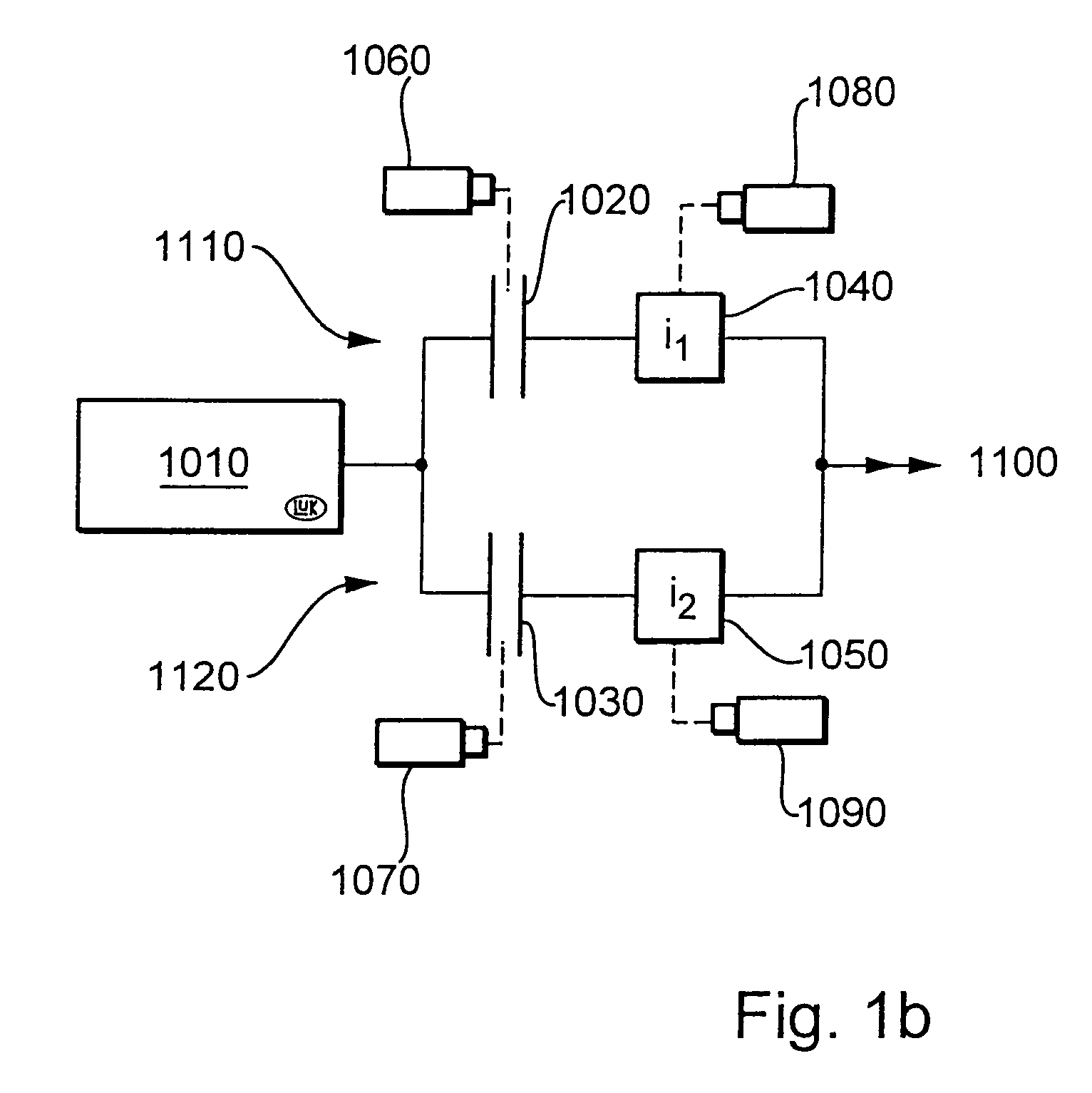[0028]An
advantage of the present invention is that with the final actuation mechanism, the primary actuation elements can immediately be brought into the
neutral position after the shift of a gear in a power
branch and need not remain in the shift passageway of the engaged gear. Moreover, in addition to driving technical aspects, safety technical aspects, for example overspeed protection for a new gear, can also be taken into consideration. The following pre-selection strategies can be advantageous:
[0029]Engaging the next higher gear: Following a shift process, that is, when the
clutch applies torque to the current drive gear of a power branch, the torque will be engaged with the current drive gear and the other, load-free power branch. If there is no higher gear, the highest gear in that branch is engaged. In that way, overspeed protection is ensured while shifting torque to that power branch. A previous, still-engaged gear is disengaged with that shift process by means of the secondary actuation element. The
clutch in that power branch remains disengaged until a shift requirement for the engaged gear is triggered by the
control logic.
[0030]Pre-selection of a lower gear: After the next higher gear is engaged in the load-free power branch following the above-described routine, the transmission
actuator is positioned in the
neutral position without again disengaging the engaged gear. Thereafter, a positioning in the selection direction occurs in a shift passageway of a gear of a
gear ratio, which is preferably smaller than that of the current drive gear and that of the gear engaged in the load-free power branch. For example, it is particularly advantageous for the gear that is calculated by the controller logic, upon a kick-down by the driver, as a target gear for maximal performance, whereby that gear can be changed during operation in that transmission position, whereupon the position of the selection
actuator can also be changed. In manual operation of the vehicle, in which the driver actively selects the next drive gear step, the selected shift passageway can be that of the gear that has the next smaller
gear ratio relative to the current drive gear. In a further variant for rapid acceleration of the vehicle, for example for an actuation of the accelerator pedal above a set threshold, the shift passageway can be selected with the gear into which the vehicle would shift if the vehicle were to continue to be constantly operated at the current speed, for example, a gear with higher
gear ratio (overdrive) for economical operation of the vehicle. It should be understood that the shift movement is tracked corresponding to the current driving situation, and thereby the current gear alternative to the gear engaged on the load-free power branch can always be kept available using a simple shift / disengage motion.
[0031]Transmissions according to the concept of the invention can also be designed according to other aspects in which it need not be considered that the gears, which are arranged adjacent with reference to their reduction in known arrangements, for example, gears 1 and 2 in one shift passageway can be arranged to be adjacent to gears 3 and 4 in the adjacent shift passageway because the new gear to be engaged can be engaged by means of the primary actuation element and the engaged gear can be disengaged using a secondary actuation element without additional selection processes. To accelerate the shift times, the new gear to be engaged can already be pre-selected as long as the engaged gear is still engaged. The shift movement can already be initiated, while the engaged gear has not yet been disengaged, so that the transmission shift
actuator can undergo a startup time before the shift process and need not be started from standstill, since, as is well known, starting up from a standstill consumes a great deal of time and delays the shift process.
[0032]It can also be advantageous for obtaining especially rapid shift processes to pre-select the likely following gear with a single branch transmission having a transmission input shaft and a transmission output shaft. The following pre-selection criteria can be advantageous as a function of the driving situation or the position of the selector lever of the transmission without a shift command to another gear having already taken place:
[0033]The selector lever is in the drive (D) position, or in manual
operation mode (M; the individual gears are actuated by the driver, for example by means of a Tiptronic control), a forward gear is engaged. As long as the vehicle travels in this
driving mode with a speed above a threshold to be established for each engaged gear, the accelerator position or longitudinal acceleration of the vehicle is evaluated to pre-select the next higher or next lower gear of the engaged gear. When the vehicle is accelerating, the next higher gear is pre-selected, when the vehicle slows down it is the next lower gear. In order to avoid unnecessary adjustment movements, a
hysteresis band can be provided in the pre-selection routine. In the highest gear, the next lower is pre-selected. In gear 1, gear 2 can be pre-selected beginning with a speed threshold to be specified, below that the
neutral position of the transmission will be pre-selected.
 Login to View More
Login to View More  Login to View More
Login to View More 


